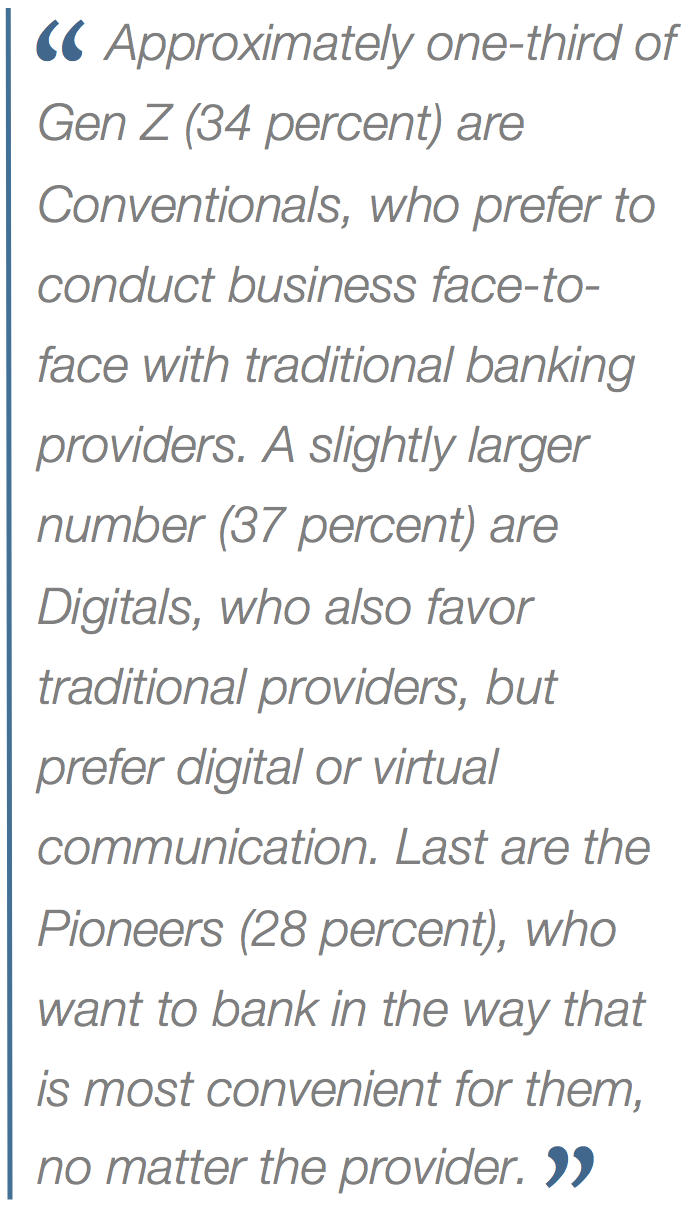


Move over millennials. Gen Z is on the scene and ready to leave its mark on banking and payments. Born after 1999, members of this demographic view the world completely differently than the generations that have gone before them.
 photo istock
photo istock
by Andrew Vahrenkamp, senior research analyst, Raddon
Move over millennials. Gen Z is on the scene and ready to leave its mark on banking and payments. Members of this demographic, born after 1999, views the world completely differently than generations that have gone before. Gen Z is more comfortable than prior generations with digital methods of moving money, and many anticipate supplementing traditional banking services with solutions from technology companies.
In its study, Generation Z: The Kids Are All Right, based on a survey of more than 2,500 high school students from 16–18 years old, Raddon, a Fiserv business, found that Gen Z is already in the payments space. Sixty-seven percent currently have a bank or credit union account, either in their own name or with their parents.
 Somewhat surprisingly, members of Gen Z don't all fit in a digital box. Approximately one-third of Gen Z (34 percent) are "Conventionals," who prefer to conduct business face-to-face with traditional banking providers.
Somewhat surprisingly, members of Gen Z don't all fit in a digital box. Approximately one-third of Gen Z (34 percent) are "Conventionals," who prefer to conduct business face-to-face with traditional banking providers.
A slightly larger number (37 percent) are "Digitals," who also favor traditional providers, but prefer digital or virtual communication.
Last are the "Pioneers" (28 percent), who want to bank in the way that is most convenient for them, no matter the provider. Pioneers are the members of Gen Z most likely to push forward the revolution in payments.
The presence of technology as an integral part of daily life will play a significant role in how Gen Z interacts with finances. Members of Gen Z have grown up in the world of the smartphone and the touch screen. Seventy-three percent use their smartphone at least once an hour.
Smartphones are not the only screens you will find Gen Z viewing. Fifty percent of those surveyed have a tablet, 75 percent have a laptop computer and 50 percent have a desktop computer.
Taking these numbers into account, it is not unreasonable to picture a Gen Z member consuming content on three or four screens simultaneously. This multiscreen viewing demands constant and unique content and also makes capturing attention more difficult, as the choices available are virtually unlimited.
Consider Gen Z's use of mobile banking, accessing a bank or credit union via app or mobile website. Currently, only 48 percent of Gen Z bank account holders use mobile banking, compared to 57 percent of adults. We expect that as Gen Z moves into college and the job market, their use of mobile banking in particular will exceed that of millennials (currently 85 percent).
With smartphone ownership outpacing laptop or desktop ownership, mobile banking appears to be more likely than online banking to win this generation in the long run.
Given the robust ownership of smartphones and an appreciation for technology among members of Gen Z, one might expect them to mirror their millennial counterparts in using their phones to purchase things at retail establishments. In fact, Gen Z is already outpacing millennials in their use of mobile payments.
Just as with mobile banking, though, attitudes toward technology are strongly predictive of mobile payments use among Gen Z segments: Only 15 percent of Conventionals have paid for something with their phone, compared with Pioneers at 45 percent and Digitals in the middle with 24 percent.
The Raddon survey revealed that members of Gen Z make mobile payments at a wide variety of establishments, including department stores (44 percent); shops selling coffee, tea and snacks (41 percent); convenience stores (33 percent); and supermarkets (28 percent).
 By embracing new payment technology, Gen Z has become open to the idea of using disruptive technology firms or other nonincumbents for future banking needs.
By embracing new payment technology, Gen Z has become open to the idea of using disruptive technology firms or other nonincumbents for future banking needs.
This generation is much more likely than those before to envision a future in which technology companies supplement financial services they receive from traditional financial institutions.
In fact 44 percent of Gen Z anticipates supplementing traditional banking services with solutions from technology companies, compared with only 37 percent of millennials and 26 percent of Gen X.
Among the three attitudinal segments of Gen Z, more than 3 out of 4 Pioneers were willing to conduct their financial business with tech companies.
The threat to traditional providers does not end there, however: As many as 31 percent of all of Gen Z members agree that they will not have to rely on banks for financial services in the future.
Disruptive technology companies are targeting the payments space more than any other portion of the industry, and Gen Z seems more willing than other generations to give them a try.
Keeping on top of trends in order to deliver the payment capabilities and experiences consumers expect will enable financial institutions to retain transactions, revenue and ultimately accounts and balances as the next generation comes of age.
Sign up now for the ATM Marketplace newsletter and get the top stories delivered straight to your inbox.
Privacy PolicySeptember 9-11, 2024 | Charlotte, NC